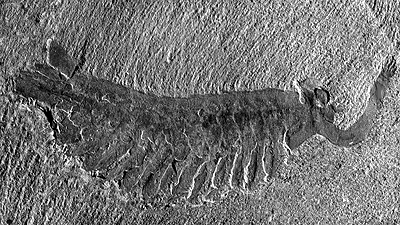
WHAT IS/WAS THE BURGESS SHALE?
THE BURGESS SHALE, a UNESCO World Heritage Site, is a vast fossil-bearing exposed deposit in the Canadian Rockies of British Columbia, Canada.
Located in Yoho National Park, near Field, BC, just west of the Alberta border. Elevation: 2286 m above sea level; 1243 m above mountain base.
508 million years ago, these mountains were ocean beds off the shores of "Laurentia", a small equatorial continent ...
This was the Cambrian Period: though the land was entirely lifeless, the broad, shallow sea banks teemed with ocean life ...
At 400 km offshore, these particular banks dropped to a depth of 160 m. This long-vanished undersea cliff has been named "Cathedral Escarpment".
At the cliff base, Life also thrived & teemed: Trilobites, Marrellas, Opabinias, sea sponges, the giant predator Anomalocarus, and much, much more ...
However, this site was also prone to mudslides; it may have been a volcanic or earthquake zone. With regularity, mud & silt was deposited at the cliff base in sudden upheavals, burying all things that happened to be in the way.
Millions of years ... Countless Cambrian sea-creatures were buried & preserved in the low-oxygen silt. Millions of more years: these silt layers grew deep, turned to rock (shale) ... The continent/coast of "Laurentia" expanded & moved, gradually becoming part of what we now call North America ...
During the time of the Dinosaurs, these sea beds were lifted high by tectonic forces, and became mountains ... At last, the shale deposits were exposed to the sky: yielding one of the most extraordinary fossil deposits in the world ...
The Burgess Shale. Discovered & named by paleontologist Charles Walcott, August 1909.
Unlike other fossil beds, the Burgess Shale preserved soft body parts as well as hard, giving science its best look at Life half a billion years ago ...
These fossil records, in fact, are so vast, it is doubtful that Science will ever excavate & catalog them all. However, Science is doing its best: the Royal Ontario Museum is leading excavation, discovering previously unknown species at an increasing pace; also planning an ambitious new permanent gallery in Toronto (2021) to display & interpret them.
FOR MORE INFORMATION -- ESSENTIAL READING:
Wonderful Life: The Burgess Shale & the Nature of History - Stephen Jay Gould
The Crucible of Creation: The Burgess Shale & the Rise of Animals -- Simon Conway Morris
A Geoscience Guide to the Burgess Shale -- Murray Coppold & Wayne Powell












